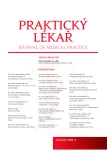Physical activity in seniors 65+ and its context with health literacy
Authors:
L. Motlová 1; I. Brabcová 2; L. Šedová 2; H. Hajduchová 2; S. Bártlová 2
Authors‘ workplace:
Ústav sociálních a speciálněpedagogických věd Ředitelka: doc. PhDr. Adéla Mojžíšová, Ph. D.
1; Jihočeská univerzita v Českých Budějovicích Zdravotně sociální fakulta Děkanka: prof. PhDr. Valérie Tóthová, Ph. D.
1; Ústav ošetřovatelství, porodní asistence a neodkladné péče Ředitelka: doc. PhDr. Sylva Bártlová, Ph. D.
2
Published in:
Prakt. Lék. 2018; 98(5): 209-213
Category:
Of different specialties
Overview
Objective:
The aim of quantitative research was to verify the influence of selected indicators (long-term illness or health problem, education, place of residence, financial situation) on physical activity in seniors 65+ living in the Czech Republic in the South Bohemian Region.
Aim:
The research file was made up of 326 people 65+ who lived in their own household in the South Bohemian Region. The criterion for inclusion was the age of respondents aged 65+, permanent residence in the South Bohemian Region, absence of cognitive impairment and living in a separate household.
Methods:
The HLS-EU-Q16 standardized questionnaire (European Questionnaire for Health Literacy Survey) was selected, which was extended by several own issues of socio-demographic nature. Data collection was conducted in the form of a structured interview conducted by trained interviewers.
Results:
A statistically significant correlation between long-term illness and movement activities in the last month has been demonstrated. There was no statistically significant link between seniors’ education and physical activities performed by seniors in the last month. A statistically significant correlation between movement activities in the last month and the place of residence of seniors has been demonstrated. There was a statistically significant correlation between the seniors• physical activities during the last 30 days and the financial situation in the form of end-of-month payment problems.
Conclusion:
It is necessary to increase the awareness of seniors about the contribution of age-related physical activity to health. Seniors need not only enough access to information about physical activity, they also need to understand this information and, in particular, learn how to use it in everyday life.
Keywords:
physical activity – long-term disease – residence – education – the financial situation – health literacy – elderly
Sources
1. Eriksson-Backa K, et al. Health information literacy in everyday life: a study of Finns aged 65–79 years. Health Informatics J 2012; 8(2): 83–94. doi: 10.1177/1460458212445797
2. Badland H, Schofield G. Understanding the relationship between town size and physical activity levels: A population study. Health & Place 2006; 12(4): 538–546. doi: 10.1016/j.healthplace.2005.08.007
3. Berkman ND, et al. Low health literacy and health outcomes: An updated systematic review. Annals of Internal Medicine 2011; 155(1): 97–107.
4. Bowman K, et al. Dynamic aging: simple exercises for whole-body mobility. Sequim, Washington: Propriometrics Press 2017.
5. Bunc V, Hráská P, Skalská M. Pohybové aktivity seniorů-benefity a možná rizika. In: Štěpánková H, Höschl C, Vidovičová, L. Gerontologie: současné otázky z pohledu biomedicíny a společenských věd. Praha: Karolinum 2014; 185–193.
6. Číková Z. Jak tráví volný čas senioři [online] 2008 [cit. 2018-06-01]. Diplomová práce. Masarykova univerzita, Lékařská fakulta. Vedoucí práce Andrea Pokorná. Dostupné z: https://is.muni.cz/th/o5z27
7. Dobrý L, Čehovská I. Zdravotní benefity pohybové aktivnost a behaviorální intervence. In: Hendl J, Dobrý I. Zdravotní benefity pohybových aktivit: monitorování, intervence, evaluace. Praha: Karolinum 2011; 16.
8. Eu physical acitivty Guidelines. Recommended Policy Actions in Support of Health-Enhancing Physical Activity 2008 [online] [cit. 2018-06-01]. Dostupné z: http://ec.europa.eu/assets/eac/sport/library/policy_documents/eu-physical-activity-guidelines-2008_en.pdf
9. Janiš K, Skopalová J. Volný čas seniorů. Praha: Grada Publishing 2016.
10. Kickbusch I, et al. Health literacy: The solid facts. World Health Organization Regional Office for Europe. Copenhagen: WHO Regional Office for Europe 2013.
11. Kobayashi LC, et al. Aging and functional health literacy: a systematic review and meta-analysis. J Gerontol B Psychol Sci Soc Sci 2016; 71(3): 445–457.
12. Maťhová L, Formánková P. Pohybová aktivita ve stáří. Rehabilitácia 2014; 51(1): 55–63.
13. Ministerstvo zdravotnictví ČR. Zdraví 2020: rámcový souhrn opatření připravených s cílem pomoci vládám a všem společenským aktivitám, aby přispívaly ke zdraví a životní pohodě obyvatel evropského regionu. Praha: Ministerstvo zdravotnictví České republiky ve spolupráci se Státním zdravotním ústavem a Kanceláří WHO v České republice 2014.
14. Mudrák J, a kol. Pohybová aktivita a subjektivní vnímání zdraví u seniorů. Česká kinantropologie 2011; 15(3): 117–129.
15. Pelclová J. Pohybová aktivita v životním stylu dospělé a seniorské populace České republiky. Olomouc: Univerzita Palackého v Olomouci, Fakulta tělesné kultury 2014.
16. Pelclová J, et al. Leisure time, occupational, domestic, and commuting physical activity of inhabitants of the Czech Republic aged 55–69: Influence of sociodemographic and environmental factors. Acta Universitatis Palackianae Olomucensis. Gymnica 2009; 39(3): 13–20.
17. Pelclová J. a kol. Vliv vybraných faktorů na pohybovou aktivitu a sezení u zaměstnaných a osob v důchodu ve věku 55–69 let. Česká kinantropologie 2008; 4(12): 49–59.
18. Teplý Z. Teoretické základy tvorby pohybových režimů a jejich praktická realizace. In: Sborník z mezinárodního vědeckého kolokvia. Praha: ČSTV 1988.
19. Watkins I, Xie B. eHealth literacy interventions for older adults: a systematic review of the literature. Journal of Medical Internet Research 2014; 16(11): 225.
20. WHO. Annual Global Move for health iniciative: a concept paper. 2003 [online] [cit. 01. 28. 2017]. Dostupné z: http://www.afro.who.int/sites/default/files/2017-06/hpr%20MoveForHealth.pdf
21. WHO. Strategy and action plan for healthy ageing in Europe, 2012–2020. 2018. [online] [cit. 01. 28. 2017]. Dostupné z: http://www.euro.who.int/_data/assets/pdf_file/0008/175544/RC62wd10Rev1-Eng.pdf?ua=1
Labels
General practitioner for children and adolescents General practitioner for adultsArticle was published in
General Practitioner

2018 Issue 5
Most read in this issue
- Flu from a general practitioner’s point of view – case report
- Physical activity in seniors 65+ and its context with health literacy
- Dry form of age related macular degeneration and nutritional supplements, use of microperimetry
- Antibiotics resistance and importance of the horizontal transmission of genetic information
